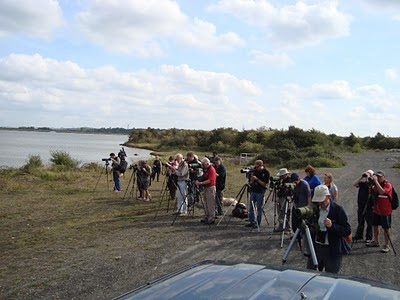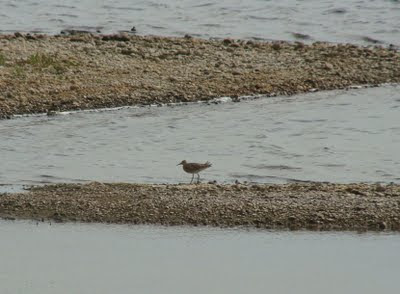Cliffe Pools gets 2 rarities in a day
I wrote this yesterday. See bottom for update.
 |
| Twitch! Cliffe Pools 25/9/11 Yours truly working hard! (to the right of chap in red shirt in centre) |
Y’know how it is – one minute you’re kinda arsing around at home, pondering what sandwich to have for lunch, the next minute the phone rings and within seconds your legging it out the door, bins in one hand, scope in the other.
Such was yesterday at Northward Hill. It was just after midday when Jen casually sauntered over to me; “so yeah, I just had a call, reports of a Pallid Harrier at Cliffe this morning...”
“WHAT?!”
“yeah...likely it roosted there last night too, could be moving east though”
“A. PALLID. FUCKING. HARRIER?!”
I think I must’ve blacked out then. Next thing I remember is hurtling down the road (er, I mean driving carefully within the designated speed limit) and planning our move. ‘Course we knew chances were slim, it had hours on us...but still...if it came down for the night it must have been around Black Barns and might still be in the area. So after checking there wasn’t a twitch causing havoc in the car park (hey- we’re pro’s ;) we headed there.
A small crowd was already gathered; they’d heard the news but rightly assumed it was too late and were enjoying the other birds on offer. Still when someone murmured “Harrier...distant” I think a few hearts raced. Then “hmm, wings...Buzzard I think”. Sigh.
Amazingly the day wasn’t over though. As we turned around someone pulled up and asked “where’s this Semipalmated Sandpiper then?”
“WHAT?!” oh, you get the picture...
We missed that too in the end, along with a small crowd that had turned up for it. It was reported as being mobile earlier that morning, so may well have snuck off out of sight. For a while, several Little Stint on the pools kept things interesting but with an obstructed view at 200metres, it was gonna take someone with balls to call it. I mean COME ON! (one of these is a Semipalmated Sandpiper, one is a Little Stint):
 |
| photo credit: L Spitalnik/Google Images |
 |
| Photo credit: Nigel Blake (RSPB-Images.com) |
Sandpiper top, Stint bottom - but you knew that didn't you?!. A good lesson and we weren’t far off either but hey, them’s the breaks. It’s just about being in the right place at the right time.
26/9/11 (update)******
And talking of the right place...tonight I got it! PALLID HARRIER back at Cliffe Pools. It was purely out of curiosity that I flicked on Birdguides this evening, just to see if anywhere in east Kent had picked up a Pallid during the day. Didn't expect the bird to be back this way, but there it was - it had been reported at Cliffe just half an hour before. After fortuitously coming by precise directions and an assurance it was there; for the second time in as many days Jen and I went into overdrive. 10 minutes later my punto was bumping down the track to Black Barn where we found a few birders on the second mound.
And maybe 10 minutes after arriving...there it was: a juvenile bird emerging out of some tall grass about 150 yards away. It came up briefly and flew a short distance along the edge a fence before going down. Repeating this a short while later. Being a juvenile, the colour was amazing, particularly its rufous, almost orange breast and the way the soft sunlight caught it will linger long in my memory. Our view was brief but in those few short moments I tried to take in and enjoy as many details as I could: the ring tail, the darker upperwings and the distinctly collared face. Chances are there won't be one back this way anytime soon.
Seems I wasn't the only one chasing a Pallid this weekend; check out some brilliant pics here












